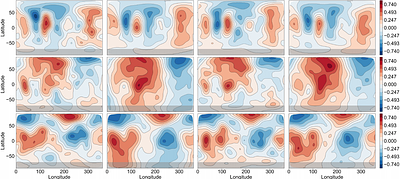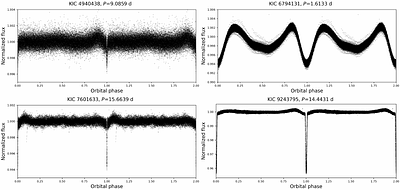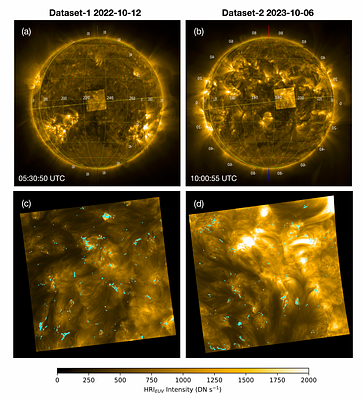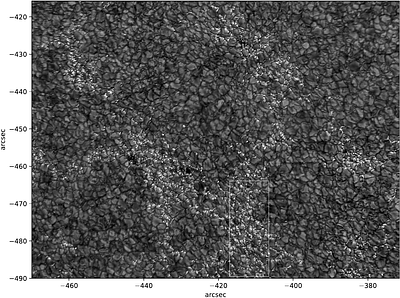By: Lin Yang, Haibo Yuan, Bowen Huang, Ruoyi Zhang, Timothy C. Beers, Kai Xiao, Shuai Xu, Yang Huang, Maosheng Xiang, Meng Zhang, Jinming Zhang
We design an uncertainty-aware cost-sensitive neural network (UA-CSNet) to estimate metallicities from dereddened and corrected Gaia BP/RP (XP) spectra for giant stars. This method accounts for both stochastic errors in the input spectra and the imbalanced density distribution in [Fe/H] values. With a specialized architecture and training strategy, the UA-CSNet improves the precision of the predicted metallicities, especially for very metal-p... more
We design an uncertainty-aware cost-sensitive neural network (UA-CSNet) to estimate metallicities from dereddened and corrected Gaia BP/RP (XP) spectra for giant stars. This method accounts for both stochastic errors in the input spectra and the imbalanced density distribution in [Fe/H] values. With a specialized architecture and training strategy, the UA-CSNet improves the precision of the predicted metallicities, especially for very metal-poor (VMP; $\rm [Fe/H] \leq -2.0$) stars. With the PASTEL catalog as the training sample, our model can estimate metallicities down to $\rm [Fe/H] \sim -4$. We compare our estimates with a number of external catalogs and conduct tests using star clusters, finding overall good agreement. We also confirm that our estimates for VMP stars are unaffected by carbon enhancement. Applying the UA-CSNet, we obtain reliable and precise metallicity estimates for approximately 20 million giant stars, including 360,000 VMP stars and 50,000 extremely metal-poor (EMP; $\rm [Fe/H] \leq -3.0$) stars. The resulting catalog is publicly available at https://doi.org/10.12149/101604. This work highlights the potential of low-resolution spectra for metallicity estimation and provides a valuable dataset for studying the formation and chemo-dynamical evolution of our Galaxy. less
By: Jennifer Rosina Andersson, Oleg Kochukhov, Zheng Zhao, Jens Sjölund
Zeeman-Doppler imaging (ZDI) is used to study the surface magnetic field topology of stars, based on high-resolution spectropolarimetric time series observations. Multiple ZDI inversions have been conducted for the early B-type star tau Sco, which has been found to exhibit a weak but complex non-dipolar surface magnetic field. The classical ZDI framework suffers from a significant limitation in that it provides little to no reliable uncertain... more
Zeeman-Doppler imaging (ZDI) is used to study the surface magnetic field topology of stars, based on high-resolution spectropolarimetric time series observations. Multiple ZDI inversions have been conducted for the early B-type star tau Sco, which has been found to exhibit a weak but complex non-dipolar surface magnetic field. The classical ZDI framework suffers from a significant limitation in that it provides little to no reliable uncertainty quantification for the reconstructed magnetic field maps, with essentially all published results being confined to point estimates. To fill this gap, we propose a Bayesian framework for probabilistic ZDI. Here, the proposed framework is demonstrated on tau Sco in the weak-field limit. We propose three distinct statistical models, and use archival ESPaDOnS high-resolution Stokes V observations to carry out the probabilistic magnetic inversion in closed form. The surface magnetic field is parameterised by a high-dimensional spherical-harmonic expansion. By comparing three different prior distributions over the latent variables in the spherical-harmonic decomposition, our results showcase the ZDI sensitivity to various hyperparameters. The mean magnetic field maps are qualitatively similar to previously published point estimates, but analysis of the magnetic energy distribution indicates high uncertainty and higher energy content at low angular degrees l. Our results effectively demonstrate that, for stars in the weak-field regime, reliable uncertainty quantification of recovered magnetic field maps can be obtained in closed form with natural assumptions on the statistical model. Future work will explore extending this framework beyond the weak-field approximation and incorporating prior uncertainty over multiple stellar parameters in more complex magnetic inversion problems. less
By: Min-Yu Li, Sheng-Bang Qian, Li-Ying Zhu, Wen-Ping Liao, Lin-Feng Chang, Er-Gang Zhao, Xiang-Dong Shi, Fu-Xing Li, Qi-Bin Sun, Ping Li
Since the variety of their light curve morphologies, the vast majority of the known heartbeat stars (HBSs) have been discovered by manual inspection. Machine learning, which has already been successfully applied to the classification of variable stars based on light curves, offers another possibility for the automatic detection of HBSs. We propose a novel feature extraction approach for HBSs. First, the light curve is transformed into the fre... more
Since the variety of their light curve morphologies, the vast majority of the known heartbeat stars (HBSs) have been discovered by manual inspection. Machine learning, which has already been successfully applied to the classification of variable stars based on light curves, offers another possibility for the automatic detection of HBSs. We propose a novel feature extraction approach for HBSs. First, the light curve is transformed into the frequency domain via Fourier transform, then the amplitudes of the first 100 harmonics are extracted, and finally these harmonics are normalised as feature vectors of the light curve. A training data set of synthetic light curves is constructed using ELLC, and their features are fed into recurrent neural networks (RNNs) for supervised learning, with the expected output being the eccentricity of these light curves. The performance of RNNs is evaluated using a test data set of synthetic light curves, achieving 95$\%$ accuracy. When applied to known HBSs from OGLE, Kepler, and TESS surveys, the networks achieve an average accuracy of 88$\%$. This method successfully identify four new HBSs within the eclipsing binary catalog of Kirk et al. The use of orbital harmonics as features for HBSs proves to be an effective approach that significantly reduces the computational cost of neural networks. RNNs show excellent performance in recognising this type of time series data. This method not only allows efficient identification of HBSs, but can also be extended to recognise other types of periodic variable stars. less
5 SciCasts by .
By: Nancy Narang, Cis Verbeeck, Marilena Mierla, David Berghmans, Frédéric Auchère, Sergei Shestov, Véronique Delouille, Lakshmi Pradeep Chitta, Eric Priest, Daye Lim, Laurent R. Dolla, Emil Kraaikamp
The extreme-ultraviolet (EUV) brightenings identified by Solar Orbiter, commonly known as campfires, are the smallest transient brightenings detected to date outside active regions in the solar corona. We investigate the spatio-temporal distribution of a large ensemble of the finest-scale EUV transient brightenings observed by the Extreme Ultraviolet Imager (EUI) aboard Solar Orbiter. We perform a statistical analysis of the EUV brightenings ... more
The extreme-ultraviolet (EUV) brightenings identified by Solar Orbiter, commonly known as campfires, are the smallest transient brightenings detected to date outside active regions in the solar corona. We investigate the spatio-temporal distribution of a large ensemble of the finest-scale EUV transient brightenings observed by the Extreme Ultraviolet Imager (EUI) aboard Solar Orbiter. We perform a statistical analysis of the EUV brightenings by using quiet-Sun observations at the highest possible spatial resolution ever obtained by EUI. We use observations in the 17.4 nm passband of the High Resolution EUV Imager (HRIEUV) of EUI acquired during the closest perihelia of Solar Orbiter in 2022 and 2023. Solar Orbiter being at a distance 0.293 AU from the Sun, these observations have an exceptionally high image scale of 105 km, recorded at a fast cadence of 3 seconds. We use a wavelet-based automatic detection algorithm to detect and characterise the events of interest, and study their morphological and photometrical properties. We report the detection of smallest and shortest lived EUV brightenings to date in the quiet-Sun. The size and lifetime of the detected EUV brightenings appear power-law distributed down to a size of 0.01 Mm$^{2}$ and a lifetime of 3 seconds. In general their sizes lie in the range of 0.01 Mm$^{2}$ to 50 Mm$^{2}$ , and their lifetimes vary between 3 seconds and 40 minutes. We find an increasingly high number of EUV brightenings at smaller spatial and temporal scales. We estimate that about 3600 EUV brightenings appear per second on the whole Sun. The HRIEUV brightenings thus represent the most prevalent, localised and finest-scale transient EUV brightenings in the quiet regions of the solar corona. less
By: D. Kuridze, F. Wöger, H. Uitenbroek, M. Rempel, A. Tritschler, T. Rimmele, C. Fischer, O. Steiner
Striated granular edges observed in the solar photosphere represent one of the smallest-scale phenomena on the Sun. They arise from the interaction of strongly coupled hydrodynamic, magnetic, and radiative properties of the plasma. In particular, modulations in the photospheric magnetic field strength cause variations in density and opacity along the line of sight, leading to their formation. Therefore, the striation patterns can be used as v... more
Striated granular edges observed in the solar photosphere represent one of the smallest-scale phenomena on the Sun. They arise from the interaction of strongly coupled hydrodynamic, magnetic, and radiative properties of the plasma. In particular, modulations in the photospheric magnetic field strength cause variations in density and opacity along the line of sight, leading to their formation. Therefore, the striation patterns can be used as valuable diagnostics for studying the finest-scale structure of the photospheric magnetic field. The Daniel K. Inouye Solar Telescope allows observations of the solar atmosphere with a spatial resolution of better than 0."03 with its current instrumentation. We analyze images acquired with the Visible Broadband Imager using the G-band channel to investigate the characteristics of fine-scale striations in the photosphere and compare them with state-of-the-art radiation-MHD simulations at similar spatial resolution. Both observed and synthetic images reveal photospheric striae with widths of approximately 20$-$50 km, suggesting that at least 4-meter class solar telescopes are necessary to resolve this ultrafine structure. Analysis of the numerical simulations confirms that the striation observed in the filtergrams is associated with spatial variations in photospheric magnetic flux concentrations, which cause shifts in the geometrical height where the emergent intensity forms. Some fine-scale striation in the synthetic images originate from magnetic field variations of approximately a hundred Gauss, resulting in a Wilson depressions as narrow as 10 km. This suggests that DKIST G-band images can trace footprints of magnetic field variations and Wilson depressions at a similar scale. less
By: Reetika Joshi, Jaroslav Dudík, Brigitte Schmieder, Guillaume Aulanier, Ramesh Chandra
In the standard 2D model of eruption, the eruption of a magnetic flux rope is associated with magnetic reconnection occurring beneath it. However, in 3D, additional reconnection geometries are possible, in particular the AR-RF, where external reconnection involving the overlying arcades (A) and erupting flux rope (R) turns into another arcade and a flare loop (F). This process results in the drifting of the legs of the erupting flux rope. We ... more
In the standard 2D model of eruption, the eruption of a magnetic flux rope is associated with magnetic reconnection occurring beneath it. However, in 3D, additional reconnection geometries are possible, in particular the AR-RF, where external reconnection involving the overlying arcades (A) and erupting flux rope (R) turns into another arcade and a flare loop (F). This process results in the drifting of the legs of the erupting flux rope. We investigated spectroscopic signatures of such AR-RF reconnection occurring in an erupting filament reconnecting with coronal arcades during a two-ribbon flare. The evolution of the erupting filament eruption is examined using observations by the Atmospheric Imaging Assembly (AIA) and the Interface Region Imaging Spectrograph (IRIS). As the filament rises into the corona, it reconnects with the surrounding arcade of coronal loops with localized brightenings, resulting in the disappearance of the coronal loops and formation of a hot flux rope, showing slipping motion of its footpoints extending to the previous footpoints of the coronal loops (AR-RF reconnection) as predicted by the 3D extensions to the Standard solar flare model. These brightenings are accompanied by the presence of strong blue-shifts in both the IRIS Si IV and Mg II lines, upto about 200 km/s. The lines are also extremely wide, with non-thermal widths above 100 km/s. Furthermore, a strongly non-Gaussian profile of the most blue-shifted component is detected at the start of the AR-RF reconnection, indicating the presence of accelerated particles and MHD turbulence, and associated with the appearance of hot plasma in the AIA 94 A passband. For the first time, an observation has been reported in which the IRIS slit successfully captures AR-RF reconnection between a filament and overlying arcades, resulting in strong blue-shifts and very broad line profiles. less





